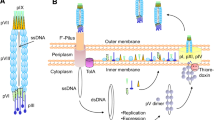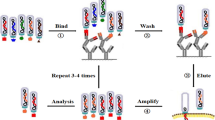Abstract
Phage display is a technology of gene expression and screening, it is widely used in the fields of defining antigen epitopes, signal transduction, genetic treatment, parasites research and tumor targeted therapy. Breast cancer is the most common cancer in women, we can obtain peptides specially associated with breast cancer by using phage display technology, and this method has great potential in early diagnosis of breast cancer and development new targeted drugs.
Similar content being viewed by others
References
Jemal A, Bray F, Center MM, et al. Global cancer statistics. CA Cancer J Clin, 2011, 61: 69–90.
Smith GP. Filamentous fusion phage: novel expression vectors that display cloned antigens on the virion surface. Science, 1985, 228: 1315–1317.
Li Q, Gao S, Yu Y, et al. A novel bFGF antagonist peptide inhibits breast cancer cell growth. Mol Med Rep, 2012, 6: 210–214.
Park HY, Lee KJ, Lee SJ, et al. Screening of peptides bound to breast cancer stem cell specific surface marker CD44 by phage display. Mol Biotechnol, 2012, 51: 212–220.
Zhong L, Ge K, Zu JC, et al. Autoantibodies as potential biomarkers for breast cancer. Breast Cancer Res, 2008, 10: R40.
Zhao W, Meng L, Gao YJ, et al. Screening of breast cancer antigen from a phage display random peptide library. Chin J Cell Mol Immunol (Chinese), 2010, 26: 951–954.
Wang J, Wang H, Wang C, et al. Isolation and identification of single chain Fv antibodies against breast cancer from a human phage display library. Chin J Cell Mol Immunol (Chinese), 2012, 28: 837–840.
Wiiger MT, Gehrken HB, Fodstad Ø, et al. A novel human recombinant single-chain antibody targeting CD166/ALCAM inhibits cancer cell invasion in vitro and in vivo tumour growth. Cancer Immunol Immunother, 2010, 59: 1665–1674.
Dong J, Liu WQ, Jiang AM, et al. A novel peptide, selected from phage display library of random peptides, can efficiently target into human breast cancer cell. Chin Sci Bull, 2008, 53: 860–867.
Chen LS, Wang AX, Dong B, et al. A new prospect in cancer therapy: targeting cancer stem cells to eradicate cancer. Chin J Cancer, 2012, 31: 564–572.
Gur D, Liu S, Shukla A, et al. Identification of single chain antibodies to breast cancer stem cells using phage display. Biotechnol Prog, 2009, 25: 1780–1787.
Li Z, Liu CP, He YL, et al. The expression and significance of multidrug resistance genes in breast cancer stem cells. Chinese-German J Clin Oncol, 2008, 7: 538–541.
Li XB, Schluesener HJ, Xu SQ. Molecular addresses of tumors: selection by in vivo phage display. Arch Immunol Ther Exp (Warsz), 2006, 54: 177–181.
Pasqualini R, Ruoslahti E. Organ targeting in vivo using phage display peptide libraries. Nature, 1996, 380: 364–366.
Arap W, Pasqualini R, Ruoslahti E. Cancer treatment by targeted drug delivery to tumor vasculature in a mouse model. Science, 1998, 279: 377–380.
Essler M, Ruoslahti E. Molecular specialization of breast vasculature: a breast-homing phage-displayed peptide binds to aminopeptidase P in breast vasculature. Proc Natl Acad Sci USA, 2002, 99: 2252–2257.
Zhang WJ, Liu XR, Li GC, et al. Construction and selection of human Fab antibody phage display library of extracellular domain of HER2. Chin J Cell Mol Immunol (Chinese), 2011, 27: 297–300.
Liu X, He Z, Zhou M, et al. Purification and characterization of recombinant extracellular domain of human HER2 from Escherichia coli. Protein Expr Purif, 2007, 53: 247–254.
Jiang B, Liu W, Qu H, et al. A novel peptide isolated from a phage display peptide library with trastuzumab can mimic antigen epitope of HER-2. J Biol Chem, 2005, 280: 4656–4662.
Author information
Authors and Affiliations
Corresponding authors
Additional information
Supported by a grant from Science and Technology Planning Project of Guangdong Province (No: 2010B031600066).
Rights and permissions
About this article
Cite this article
Kong, M., Wang, J. & Li, B. Application of phage display technology in targeted therapy of breast cancer. Chin. -Ger. J. Clin. Oncol. 12, 246–248 (2013). https://doi.org/10.1007/s10330-013-1141-y
Received:
Revised:
Accepted:
Published:
Issue Date:
DOI: https://doi.org/10.1007/s10330-013-1141-y




